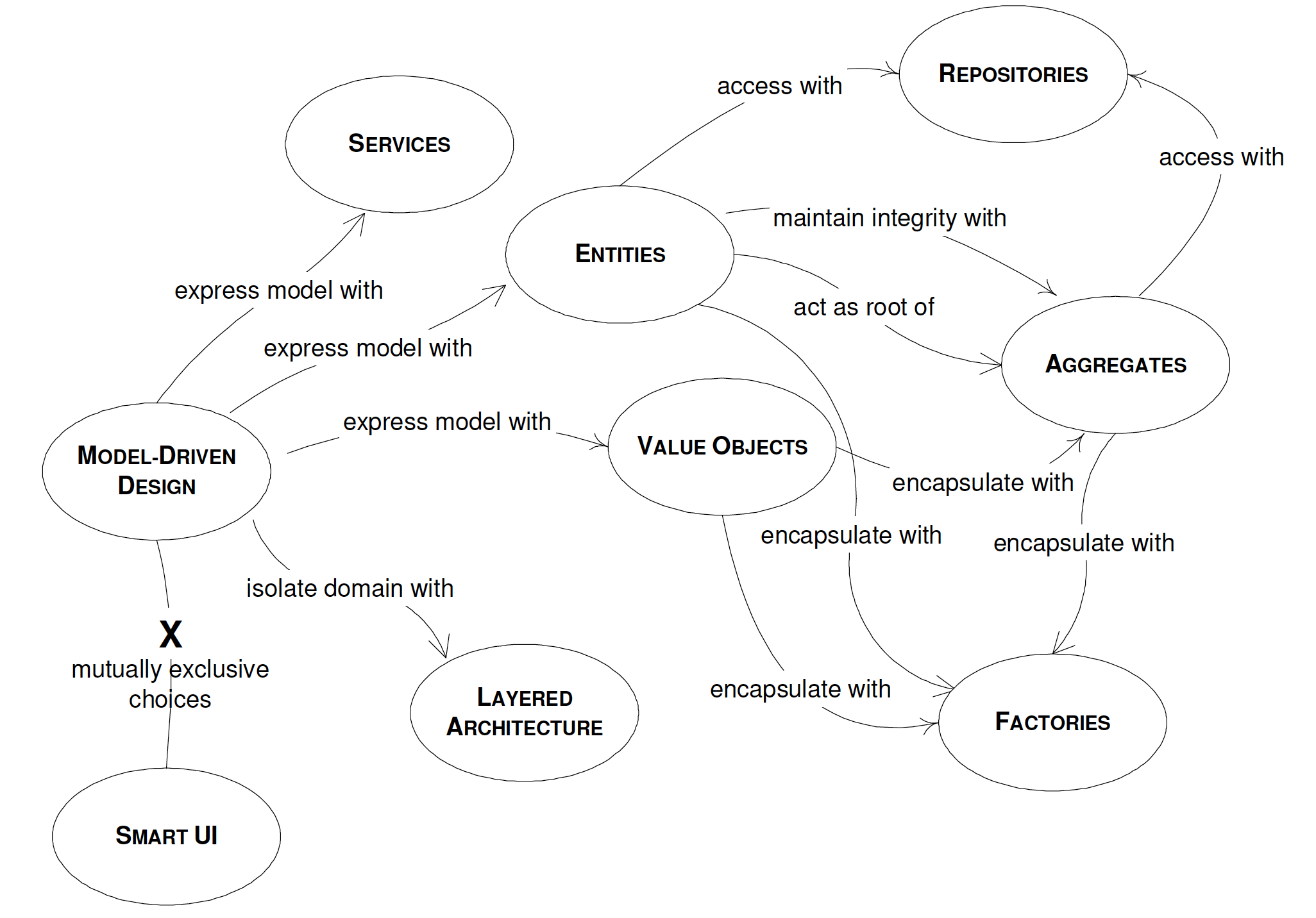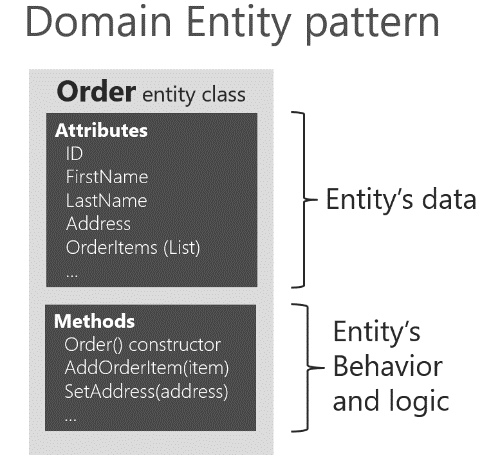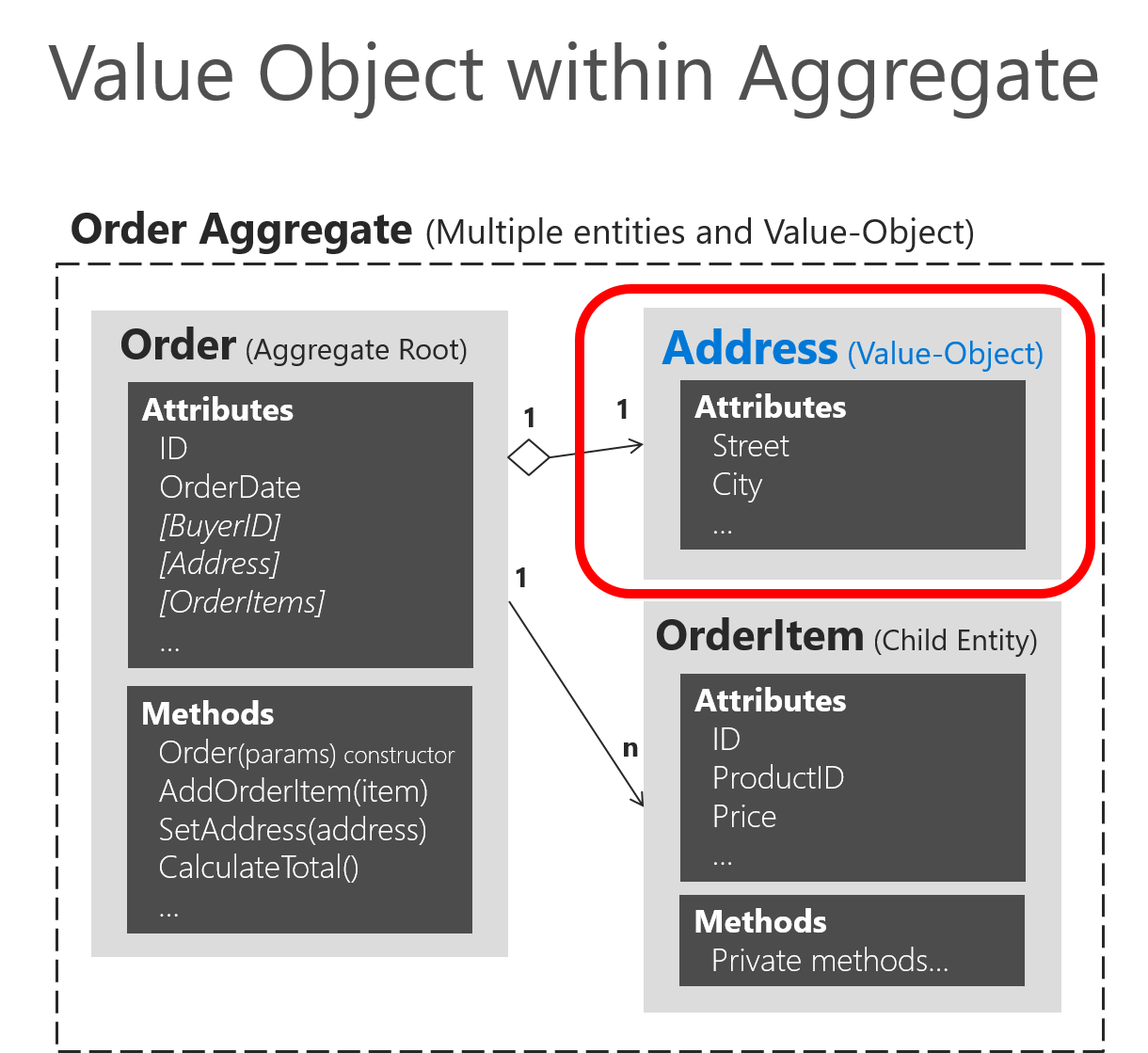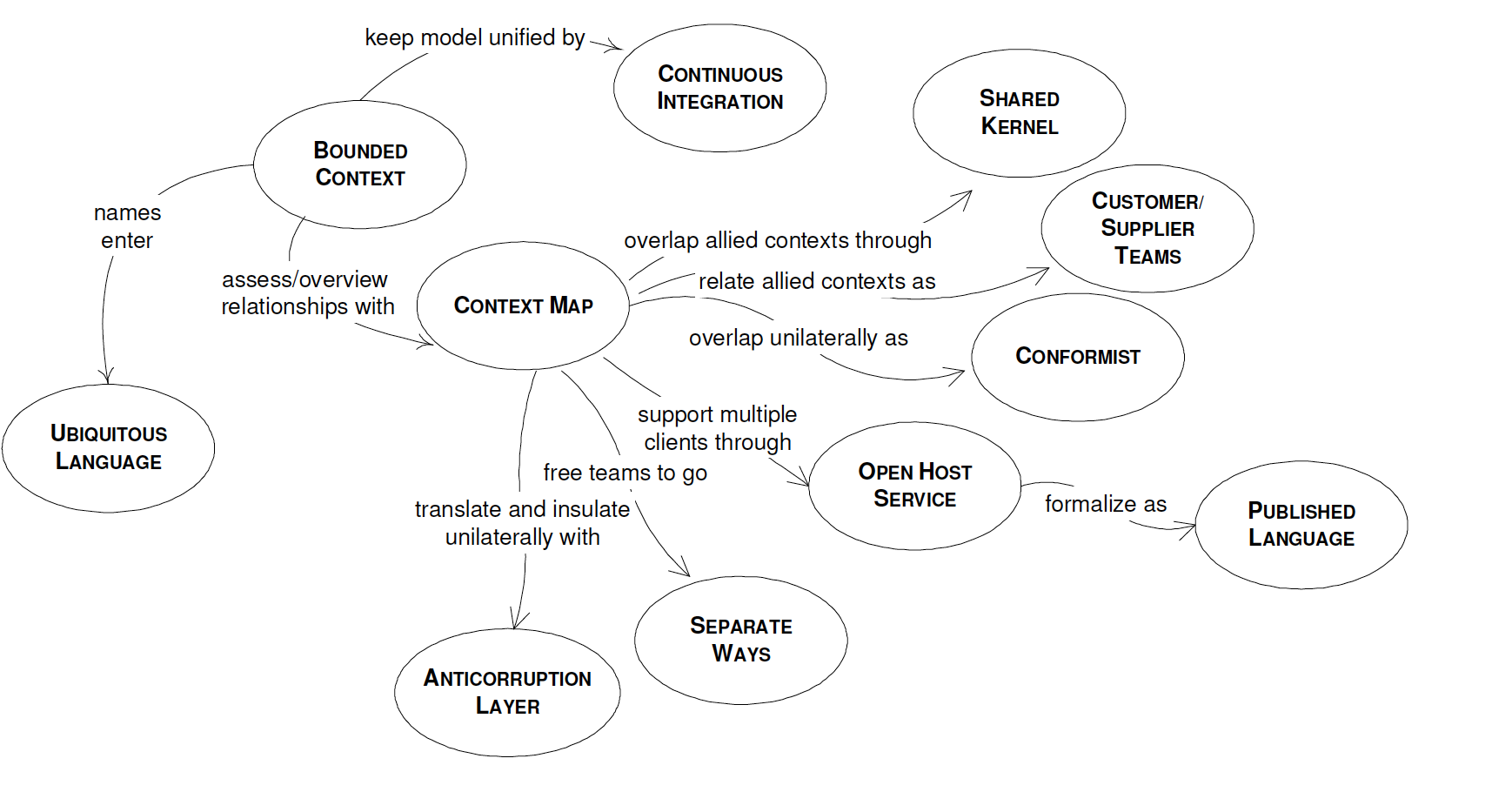Daniel
Domain Driven Design Quickly
1. What Is Domain-Driven Design
When we begin a software project, we should focus on the domain it is operating in. The entire purpose of the software is to enhance a specific domain. To be able to do that, the software has to fit harmoniously with the domain it has been created for. Otherwise it will introduce strain into the domain, provoking malfunction, damage, and even wreak chaos.
The best way to do it is to make software a reflection of the domain. Software needs to incorporate the core concepts and elements of the domain, and to precisely realize the relationships between them. Software has to model the domain.
Software which does not have its roots planted deeply into the domain will not react well to change over time.
There are different approaches to software design.
- One is the waterfall design method. This method involves a number of stages. The business experts put up a set of requirements which are communicated to the business analysts. The analysts create a model based on those requirements, and pass the results to the developers, who start coding based on what they have received. It’s a one way flow of knowledge. While this has been a traditional approach in software design, and has been used with a certain level of success over the years, it has flaws and limits. The main problem is that there is no feedback from the analysts to the business experts or from the developers to the analysts.
- Another approach is the Agile methodologies, such as Extreme Programming(XP). These mehodologies are a collective movement against the waterfall approach, resulting from the difficulties of trying to come up with all the requirements upfront, particularly in light of requirements change. It’s really hard to create a complete model which covers all aspects of a domain upfront. It takes a lot of thinking, and often you just cann’t see all the issue involved from the beginning, nor can you foresee some of the nagative side effects or mistakes of your design. Another problem Agile attempts to solve is the so called “analysis paralysis”, with team members so afraid of making any design decisions that they make no progress at all. While Agile advocates recognize the imporance of design decision, they resist upfront design. Instead they employ a great deal of implementation flexibility, and through iterative development with continuous business stakeholder participation and a lot of refactoring, the development team gets to learn more about the customer domain and can better produce software that meets the customers needs.
2. The ubiquitous Language
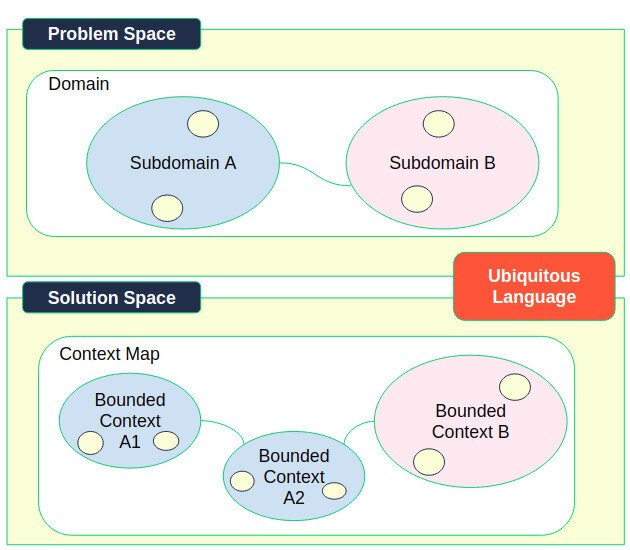
The Need for a Common Language
A project faces serious problems when team members don’t share a common language for discussing the domain. Domain experts use their jargon while technical team members have their own language tuned for discussing the domain in terms of design.
Creating the Ubiquitous Language
We can use documents. One advisable way of communicating the model is to make some small diagrams each containing a subset of the model.
3. MODEL-DRIVEN DESIGN
Any domain can be expressed with many models, and any model can be expressed in various ways in code. For each particular problem there can be more than one solution. It is important to choose a model which can be easily and accurately put into code.
Those who write the code should know the model very well, and should feel responsible for its integrity. They should realize that a change to the code implies a change to the model.
Any technical person contributing to the model must spend some time touching the code, whatever primary role he or she plays on the project. Anyone responsible for changing code must learn to express a model through the code. Every developer must be involved in some level of discussion about the model and have contact with domain experts. Those who contribute in different ways must consciously engage those who touch the code in a dynamic exchange of model ideas through the Ubiquitous Language.
Design a portion of the software system to reflect the domain model in a very literal way, so that mapping is obvious.
Object-oriented programming is suitable for model implementation because they are both based on the same paradigm.
The Building Blocks Of A Model-Driven Design
- Layered Architecture
Develop a design within each LAYER that is cohesive and that depends only on the layers below. Follow standard architectural patterns to provide loose coupling to the layers above. Concentrate all the code related to the domain model in one layer and isolate it from the user interface, application, and infrastructure code.
- Presentation Layer
Responsible for presenting information to the user and interpreting user commands.- Application Layer
This is thin layer which coordinates the application activity. It does not contain business logic. It does not hold the state of the business objects, but it can hold the state of an application task progress.
The application layer is a thin layer which stands between the user interface, the domain and the infrastructure.- Domain Layer
This layer contains information about the domain. This is the heart of the business software. The state of business objects is held here. Persistence of the business objects and possibly their state is delegated to the infrastructure layer.- Infrastructure Layer
This layer acts as a supporting library for all the other layers. It provides communication between layers, implements persistence for business objects, contains supporting libraries for the user interface layer, etc.
The domain layer should be focused on core domain issues. It should not be involved in infrastructure activities. The UI should neither be tightly connected to the business logic, nor to the tasks which normally belong to the infrastructure layer. An application layer is necessary in many cases. There has to be a manager over the business logic which supervises and coordinates the overall activity of the application.
- Entities
For these objects it is not the attributes which matter, but a thread of continuity and identify, which spans the life of a system and can extend beyond it. Such objects are called entities.
Implementing entities in software means creating identity.
- Value Objects
There are cases when we need to contain some attributes of a domain element. We are not interested in which object it is, but what attributes it has. An object that is used to describe certain aspects of a domain, and which does not have identity, is named Value Object.
It is highly recommended that value objects be immutable. They are created with a constructor, and never modified during their life time. When you want a different value for the object, you simply create another one. This has important consequences for the design. Being immutable, and having no identity, Value Objects can be shared. That can be imperative for some designs.
If Value Objects are sharable, they should be immutable. Value Objects should be kept thin and simple. When a Value Object is needed by another party, it can be simply passed by value, or a copy of it can be created and given. Making a copy of a Value Object is simple, and usually without any consequences. If there is no identity, you can make as many copies as you wish, and destroy all of them when necessary.
Domain entities must implement behavior in addition to implementing data attributes.
- Service
Such an object does not have an internal state, and its purpose is to simply provide functionality for the domain.
A Service can group related functionality which serves the Entities and the Value Objects.
A high degree of coupling between many objects is a sign of poor design because it makes the code difficult to read and understand, and more importantly, it makes it difficult to change.
A Service should not replace the operation which normally belongs on domain objects. But when such an operation stands out as an important concept in the domain, a Service should be created for it.
Make the Service is stateless.
Both application and domain Services are usually built on top of domain Entities and Values providing required functionality directly related to those objects.
- Modules
Modules are used as a method of organizing related concepts and tasks in order to reduce complexity.
Communicational cohesion is achieved when parts of the module operate on the same data. The functional cohesion is achieved when all parts of the module work together to perform a well-defined task.
Aggregate is a domain pattern used to define object ownership and boundaries. Factories and Repositories are two design patterns which help us deal with object creation and storage.
- Aggregates
An Aggregate is a group of associated objects which are considered as one unit with regard to data changes. The Aggregate is demarcated by a boundary which separates the objects inside from those outside. Each Aggregate has one root. The root is an Entity, and it is the only object accessible from outside. The root can hold references to any of the aggregate objects, and the other objects can hold references to each other, but an outside object can hold references only to the root object.
Since other objects can hold references only to the root, it means that they cannot directly change the other objects in the aggregate. All they can do is to change the root, or ask the root to perform some actions.
Object inside an Aggregate should be allowed to hold references to roots of other Aggregates.
- Factories
Factories are used to encapsulate the knowledge necessary for object creation, and they are especially useful to create Aggregates. When the root of the Aggregate is created, all the objects contained by the Aggregate are created along with it, and all the invariants are enforced.
Entity Factories and Value Object Factories are different. Values are usually immutable objects, and all the necessary attributes need to be produced at the time of creation. When the object is created, it has to be valid and final. It won’t change. Entities are not immutable. They can be changed later, by setting some of the attributes with the mention that all invariants need to be respected. Another difference comes from the fact that Entities need identity, while Value Objects do not.
The Factory is concerned with the creation of objects.
- Repositories
Use a Repository, the purpose of which is to encapsulate all the logic needed to obtain object references. The domain objects won’t have to deal with the infrastructure to get the needed references to other objects of the domain. They will just get them from the Repository and the model is regaining its clarity and focus.
Domain model is decoupled from the need of storing objects or their references, and accessing the underlying persistence infrastructure.
Keep the client focused on the model, delegating all object storage and access to the Repository.
The Repository takes care of already existing objects.
Factories are “pure domain”, but Repositories can contain links to the infrastructure, e.g. the datebase.
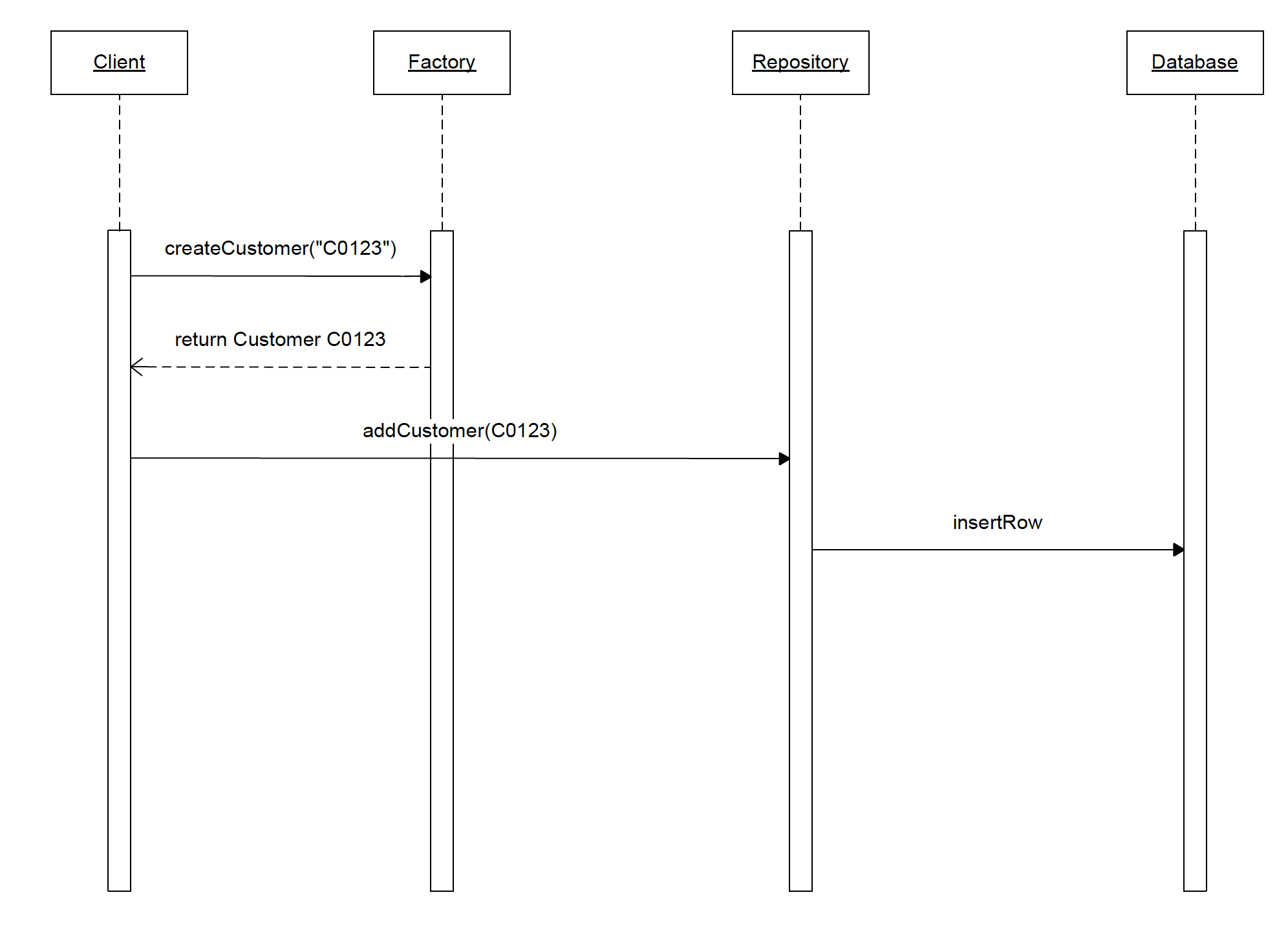
4. Refactoring Toward Deeper Insight
Continuous Refactoring
The purpose of refactoring is to make the code better not worse. Automated tests are of great help to ensure that we haven’t broken anything.
One of the first things we are taught about modeling is to read the business specifications and look for nouns and verbs. The nouns are converted to classes, while the verbs become methods.
Traditionally, refactoring is described in terms of code transformations with technical motivations. Refactoring can also be motivated by an insight into the domain and a corresponding refinement of the model or its expression in code.
Bring Key Concepts Into Light
When building knowledge it is possible to run into contradictions. What a domain expert says seem to contradict what another upholds. A requirement may seem to contradict another. Some of the contradictions are not really contradictions, but different ways of seeing the same thing, or simply lack of accuracy in explanations. We should try to reconile contradictions. Sometimes this brings to light important concepts. Even if it doesn’t, it is still important to keep everything clear.
- A constraint is simple way to express an invariant. Whatever happens to the object data, the invariant is respected. This is simply done by putting the invariant logic into a Constraint. Placing the Constraint into a separate method has the advantage of making it explicit.
- Processes are usually expressed in code with procedures. We won’t use a procedural approach, since we are using an object-oriented language, so we need to choose an object for the process, and add a behavior to it. The best way to implement processes is to use a Service.
- A Specification is used to test an object to see if it satifies a certain criteria.
The domain layer contains business rules which are applied to Entities and Value Objects. Those rules are usually incorporated into the objects they apply to. Some of these rules are just a set of questions whose answer is “yes” or “no”. Such rules can be expressed through a series of logical operations performed on Boolean values, and the final result is also a Boolean.
Such business rules can be large and complex, bloating the object to the point that it no longer serves its orginal purpose. At this point we might be tempted to move the entire rule to the application level, because it seems that it stretches beyond the domain level. Actually, it is time for a refactoring.
The rule should be encapsulated into an object of its own, which becomes the Specification, and should be kept in the domain layer.
The Specification is used to test objects to see if they fulfill some need, or if they are ready for some purpose. It can also be used to select a certain object from a collection, or as a condition during the creation of an object.
5. Preserving Model Integrity
Preserving the model integrity by striving to maintain one large unified model for the entire enterprise project is not going to work. The solution is not so obvious, because it is the opposite of all we have learned so far. Instead of trying to keep one big model that will fall apart later, we should consciously divide it into serveral models. Serveral models well integrated can evolve independently as long as they obey the contract they are bound to. Each model should have a clearly delimited border, and the relationships between models should be defined with precision.
- Bounded Context
A model should be small enough to be assigned to one team. Team cooperation and communication is more fluid and complete, which helps the developers working on the same model.
A Bounded Context is not a Module. A Bounded Context provides the logical frame inside of which the model evolves. Modules are used to organize the elements of a model, so Bounded Context encompasses the Module.
- Continuous Integration A model is not fully defined from the beginning. It is created, then it evolves continuously based on new insight in the domain and feebback from the development process. That means that new concepts may enter the model, and new elements are added to the code. All these need are to be integrated into one unified model, and implemented accordingly in code. That’s why Continuous Integration is a necessary process within a Bounded Context. We need a process of integration to make sure that all the new elements which are added fit harmoniously into the rest of the model, and are implemented correctly in code. We need to have a procedure used to merge the code. The sooner we merge the code the better.
- Context Map
An enterprise application has multiple models, and each model has its own Bounded Context. A Context Map is a document which outlines the different Bounded Contexts and the relationships between them.
- Shared Kernel
The purpose of the Kernel is to reduce duplication, but still keep two separate context.
- Customer-Supplier
The contexts in which those two subsystems exist are different, and the processing result of one system is fed into the other.
- Conformist
When two development teams have a Consumer-Supplier relatioship in which the supplier team has no motivation to provide for the customer team’s needs, the customer team is helpless. The most obvious one is to separate from the supplier and to be completely on their own.
- Anticorruption Layer
- Separate Ways
- Open Host Service
Define a protocol that gives access to your subsystem as a set of Services. Open the protocol so that all who need to integrate with you can use it. Enhance and expand the protocol to handle new integration requirements, except when a single team has idiosyncratic needs. Then, use a one-off translator to augment the protocol for that special case so that the shared protocol can stay simple and coherent.
- Distillation
Boil the model down. Find the Core Domain and provide a means of easily distinguishing it from the mass of supporting model and code. Emphasize the most valuable and specialized concepts. Make the Core small.
